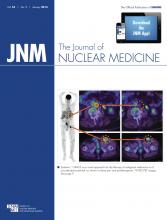REPLY: We cannot really understand the concerns of Dr. Kawada regarding our study (1). It appears that there is a general misunderstanding concerning the central message of our study. Our study on newly diagnosed and untreated brain lesions provides evidence that there is a wide overlap of tumor-to-brain 18F-FET uptake ratios in various lesions resulting in only moderate accuracy for differential diagnosis of primary brain lesions, especially in terms of differentiation between high- and low-grade glioma.
On the basis of frequently asked clinical questions at initial diagnosis, that is, whether the diagnostic method is able to separate benign lesions from neoplastic lesions, high-grade glioma from low-grade glioma, or malignant (high-grade) lesions from low-grade glioma and nonneoplastic lesions, we divided the patient collective into corresponding groups for receiver-operating-characteristic curve analysis.
With respect to differentiation between high-grade and low-grade glioma, we stated that the diagnostic accuracy of 18F-FET PET is not sufficient to decisively influence treatment decisions and that histologic confirmation by biopsy or open surgery remains necessary.
On the other hand, we observed that the tumor-to-brain 18F-FET uptake ratio at initial diagnosis may provide important information for decision making. We observed that 18F-FET uptake beyond a cutoff of 2.5 for maximum tumor-to-brain ratio resulted in a positive predictive value of 98% for neoplastic lesions and supports the necessity of an invasive procedure, such as biopsy or surgical resection. Furthermore, a maximum tumor-to-brain ratio of less than 2.5 yielded a negative predictive value of 84% for high-grade tumors, such as high-grade glioma or lymphomas.
Thus, the finding of low 18F-FET uptake may support the clinical decision to follow a watch-and-wait strategy, especially when the clinical course and MR imaging findings additionally suggest a benign process. Therefore, our statement that 18F-FET uptake ratios provide valuable additional information for both the differentiation of cerebral lesions and the grading of gliomas is justified.
With respect to ROC analysis, we used the commercially based statistical software Sigma Plot (version 11.0; Systat Software Inc.), and there is no reason that this software should lead to results different from those provided by MedCalc.
In the discussion, we pointed out that we cannot support the view of other authors that 18F-FET PET provides excellent performance for diagnosing primary brain tumors (2). In our opinion, the value of 18F-FET PET during the initial diagnosis of cerebral lesions lies especially in defining an optimal site for biopsy and determining the extent of metabolically active tumor for treatment planning rather than in making a differential diagnosis of the lesion.
Footnotes
Published online ▪▪▪.
- © 2014 by the Society of Nuclear Medicine and Molecular Imaging, Inc.







